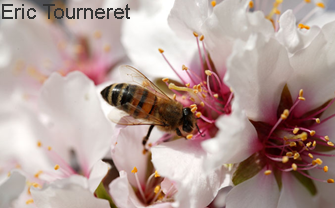Honey Bees in Agriculture
Ruth O’Neill, Research Associate
Wanner Crop Entomology Lab, Plant Sciences & Plant Pathology
Honey bee colonies travel thousands of miles each year, pollinating important food crops and producing abundant honey.
Honey production:
Montana is ranked 4th in the United States for volume of honey production. In 2012
Montana sold 13.3 million pounds of honey at an average price of $1.64 per pound (NASS
Montana Agricultural Statistics 2012:http://www.nass.usda.gov/Statistics_by_State/Montana/Publications/Annual
_Statistical_Bulletin/2012/2012_Bulletin.pdf ).
Montana’s major crops – wheat, barley, oats, corn, sugar beet, potato, dry peas and beans – are not visited by honey bees. However, there are many other important crops that need insect pollination and are very attractive to honey bees. These include forage legumes (e.g., alfalfa, sainfoin, sweet clover, birds-foot trefoil, cicer milkvetch, red clover), Brassica seed crops (e.g., table mustard seed, canola), vine crops (e.g., cucumber, pumpkin), stone fruits and pomes (e.g., cherry, plum, pear, apple), small fruits (raspberry, gooseberry, huckleberry, strawberry), and cereal (e.g., buckwheat). In addition, honey bees find important nectar sources on a wide variety of plant species growing on public lands, in shelter belts, and in urban parks and gardens.
Migratory hives:
 Most commercial beekeepers in the northern U.S. states truck their hives to orchards
in warmer regions, starting in mid-winter. The proceeds from migratory hive fees
rival honey profits, and they offer a more stable income source given the fluctuation
in nectar flow from one year to the next.
Most commercial beekeepers in the northern U.S. states truck their hives to orchards
in warmer regions, starting in mid-winter. The proceeds from migratory hive fees
rival honey profits, and they offer a more stable income source given the fluctuation
in nectar flow from one year to the next.
Montana is an important supplier of migratory hives to almond, citrus, apple, and pear growers in other states. California, the biggest almond producer in the U.S., has a half-million acres of almond trees, each acre requiring two or more hives. Almond producers currently pay approximately $50 per season for each hive. Migratory hives are moved to almond orchards in February.
After almond pollination, most migratory hives spend additional time in Oregon and Washington pollinating apples, pears, and cherries before returning to Montana in time for the spring nectar flow.
Pollination of crops:
Honey bees are important, even critical in some cases, for the pollination of many crops including forage legumes grown for seed production, such as alfalfa and sainfoin; Brassica seed crops such as table mustard seed and canola); vine crops such as pumpkin and cucumber; apple and cherry orchards; small fruits such as raspberry, huckleberry, and strawberry; and cereals such as buckwheat. Bumble bees, solitary bees, butterflies, flies, beetles, and many other animals also pollinate crops.
